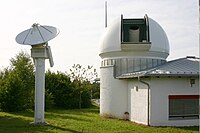
Photo from wikipedia
Currently, the requirements of the Global Geodetic Observing System are not yet met by the latest global terrestrial reference frames (TRF). In this study, we assess potential TRF improvements by… Click to show full abstract
Currently, the requirements of the Global Geodetic Observing System are not yet met by the latest global terrestrial reference frames (TRF). In this study, we assess potential TRF improvements by future SLR network designs partly already classified as “future stations” by the International Laser Ranging Service. We simulate the space geodetic techniques GPS, SLR, and VLBI within the time span 2008–2014 and evaluate the feasible improvements of the SLR-only and the multi-technique TRFs w.r.t. the current station networks. The station performance of the simulated 14 additional SLR stations is driven by the total cloud coverage from the numerical weather model ERA5. We find that the estimated station positions and velocities as well as the Earth rotation parameters, and the TRF-defining parameters origin and scale improve by 1–4% if a single additional station is added to the current SLR-only network. The solution with all 14 additional stations improves by about 22% in origin and 20% in scale w.r.t. the current SLR-only TRF. Single existing stations were excluded from the network resulting in deteriorations of 2–6%. Multi-technique TRFs improve by new co-located sites due to additional SLR stations by up to 1% for station positions, velocities, and the realization of the orientation.
Journal Title: Journal of Geodesy
Year Published: 2019
Link to full text (if available)
Share on Social Media: Sign Up to like & get
recommendations!